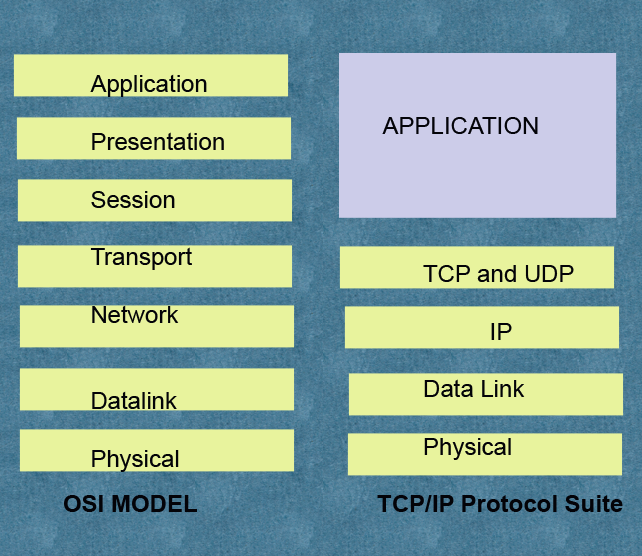What difference between OSI and TCP/IP models in detail?
Hello friends, In this blog post(Difference between OSI and TCP-IP Model) I am going to let you know about the differences between OSI and TCP-IP Model – OSI vs TCP-IP.
In this blog post(Difference between OSI and TCP-IP Model), we will go through What is the difference between TCP and IP? Which is older TCP IP or OSI? What is the TCP IP model explained in detail? What are the advantages of the TCP IP model over the OSI model? What are the differences between the OSI and TCP IP models?
Since the TCP/IP protocol was designed before the OSI model, therefore the layers in TCP-IP do not correspond exactly to the OSI layers. The application layer in TCP-IP is equivalent to the combined session, presentation, and application layers of the OSI model|Difference between OSI and TCP-IP Model|
This signifies that all the functionalities associated with those three layers are handled in one single layer, the application layer as shown in the below-given fig|Difference between OSI and TCP-IP Model|

In other words, every application program must include all tasks assigned to the session, presentation, and application layer of the OSI Model.
This has one advantage, each application program is independent.
It requires only those functions needed for the job for which the application is designed.
One disadvantage is that the same tasks appear in different application programs, making them more complex.
This damages the whole concept of modularity and layered architecture of the OSI model.
The comparison of the OSI and TCP-IP models is as follows:-
Similarities: OSI vs TCP-IP
Both are based on the concept of a stack of independent protocols.
The functionality of the layers is roughly similar.
For example, In both models, the layers up through and including the transport layer are there to provide an end-to-end network-independent transport service to processes wishing to communicate.
These layers form the transport provider. Again in both models, the layers above transport are application-oriented users of transport services.
Differences: OSI vs TCP-IP
The OSI model focuses on three concepts –
Services:
Each layer performs some services for the layers above it.
The service definition tells what the layer does, not how the entities above it access it out how the layer works.
Interfaces:
A layer’s interface tells the processes above it how to access it. It tells nothing about the layer’s internal workings.
Protocols:
The peer protocols used in a layer carry out all the activities/transactions of the layer.
They are internal to the layer and the layer can choose any among the set to carry its business and also change them at will.
The TCP-IP model did not originally clearly distinguish between services, interfaces, and protocols.
Consequently, the protocols in the OSI model are better hidden than in the TCP-IP model and can be replaced relatively easily as the terminology changes.
The OSI reference model was devised before the protocols were invented.
This ordering means that the model was not biased towards one particular set of protocols but the problem was that the…
… designer did not have much experience with the subject and did not have a good idea of which functionality to put in which layer.
In the TCP-IP model, the protocols came first, and the mode was just a description of the existing protocols.
There was no problem with the protocols fitting the model.
The only trouble was that the model did not fit any other protocol stacks.
The two models also differ in the number of layers – the OSI model has seven-layer and the TCP-IP has four layers.
Both have network, transport, and application layers, but the other layers are different.
The OSI Model supports both connectionless and connection-oriented communication in the network layer, but only connection-oriented communication in the transport layer.
The TCP-IP model supports only connectionless communication in the network layer but supports both modes in the transport layer giving the users a choice.
See the quick revision:
What is the difference between TCP and IP?
The TCP protocol is responsible for the sure delivery of a data packet whereas IP is used for logical addressing.
This means that IP found out the address and TCP takes the responsibility to deliver the packet with all safety.
Which is older TCP IP or OSI?
As we know the TCP/IP model is a real and practically implemented model on the Internet and the OSI model is a hypothetical model of communication.
The TCP/IP model is older than the OSI model which came approx 10 years before the OSI model.
What is the TCP IP model explained in detail?
TCP/IP model stands for transmission control protocol and internet protocol. This is the real model that is being used in the current network architecture or over the internet.
This model with the help of its protocol makes sure the delivery of data packets from source to destination or on the internet. This protocol also supports the naming of the addressing scheme.
Go through this extensive blog over TCP/IP…
Check out the details about the SOI model…
What are the advantages of the TCP IP model over the OSI model?
The TCP/IP model is very flexible in terms of use and ease.
It is a scalable client-server architecture and it can easily add a new network to the existing architecture without disrupting the currently running services.
The computer device information becomes very transparent in the network and it is easy to identify a system in the network as it assigns the IP address to each computer in the network.
You can also go through a few more amazing blog links related to computer networks:
Framing: Methods For Framing In Data Link Layer…
What are the design issues of the data link layer…
What is a wireless LAN standard…
SNA: System Network Architecture…
DNA: Digital Network Architecture…
Communication Oriented Network in Hindi…
Difference between OSI and TCP-IP models…
What do you mean by the TCP IP model…
Functions Of Each Layer In The OSI Model…
Bit Stuffing In Computer Network…
Conclusion:
Using this blog(Difference between OSI and TCP-IP Model) we have gone through What is the difference between TCP and IP? Which is older TCP IP or OSI? What is the TCP IP model explained in detail? What are the advantages of the TCP IP model over the OSI model? What are the differences between the OSI and TCP IP models?
In the case of any queries, you can write to us at a5theorys@gmail.com we will get back to you ASAP.
Hope! you would have enjoyed this post about the difference between OSI and TCP-IP models.
Please feel free to give your important feedback in the comment section below|Difference between OSI and TCP-IP Model|
Have a great time! Sayonara!


